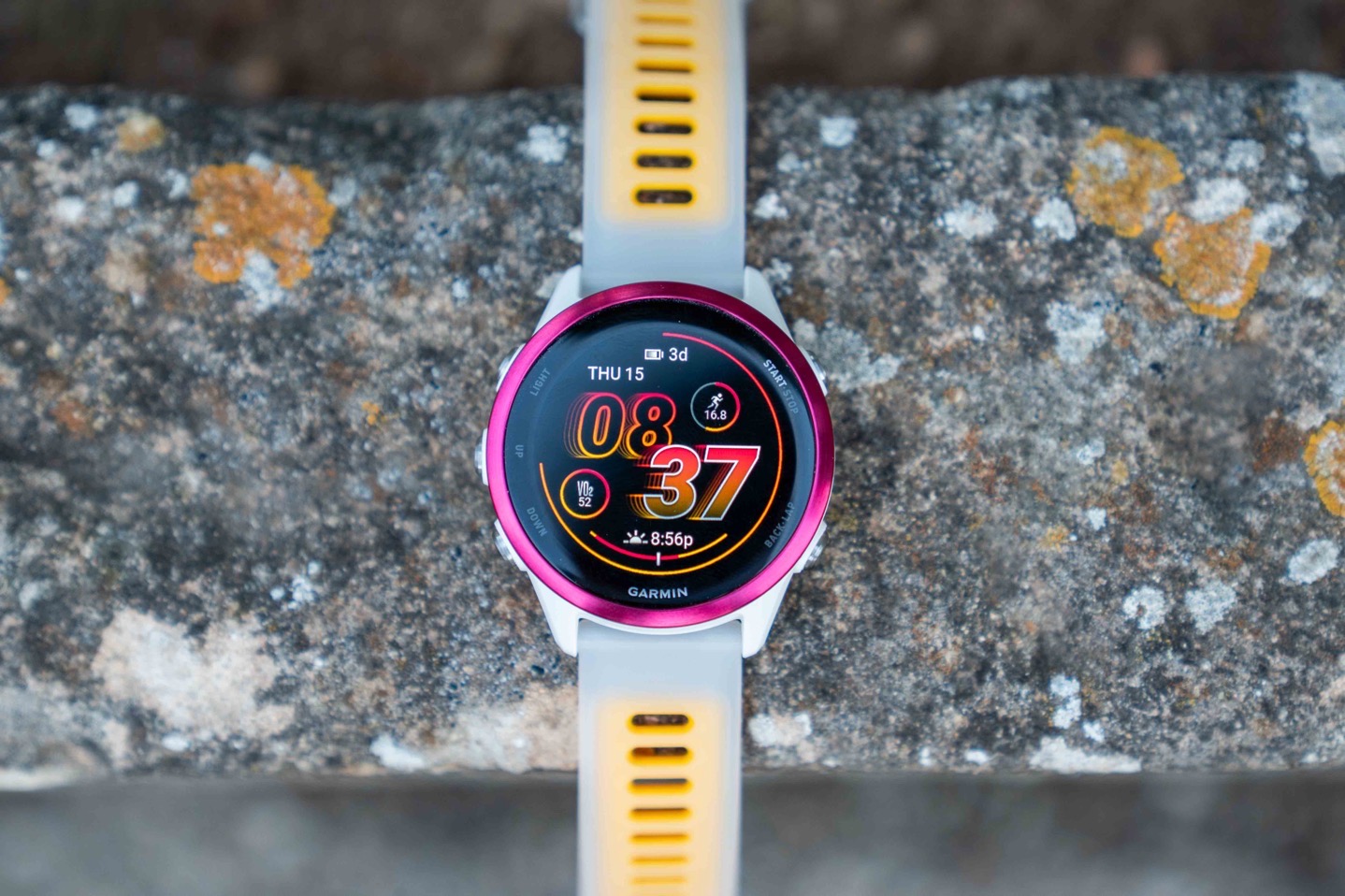
Garmin has announced the new Forerunner 570, which is the confirmed successor to the Forerunner 265. Yes, you read that right – Garmin has switched up the numerics for funsies. Or, perhaps they just did it to toy around with all the rumor sites. Either way, the Forerunner 570 is here as the mid-range Forerunner, with the new Forerunner 970 taking the top-dog spot.
The Forerunner 570 adds in a pile of features, both hardware and software. Think of it as if the Venu 3 and the Forerunner 265 merged together, yet, somehow also added their prices together too. It’s got the smartwatch features of the Venu 3, including a speaker and microphone for taking calls, while increasing the sports features found on the Forerunner series. It also features the newer Garmin Elevate Gen5 optical HR sensor, though, with a catch.
Speaking of catches, there’s also the price – the price has surged here, up to $549 (from $449). Nearly the price of the Forerunner 965, which was at $599. And yes, we’re definitely gonna chat about this price. First though, let’s run through all the newness.
What’s New:
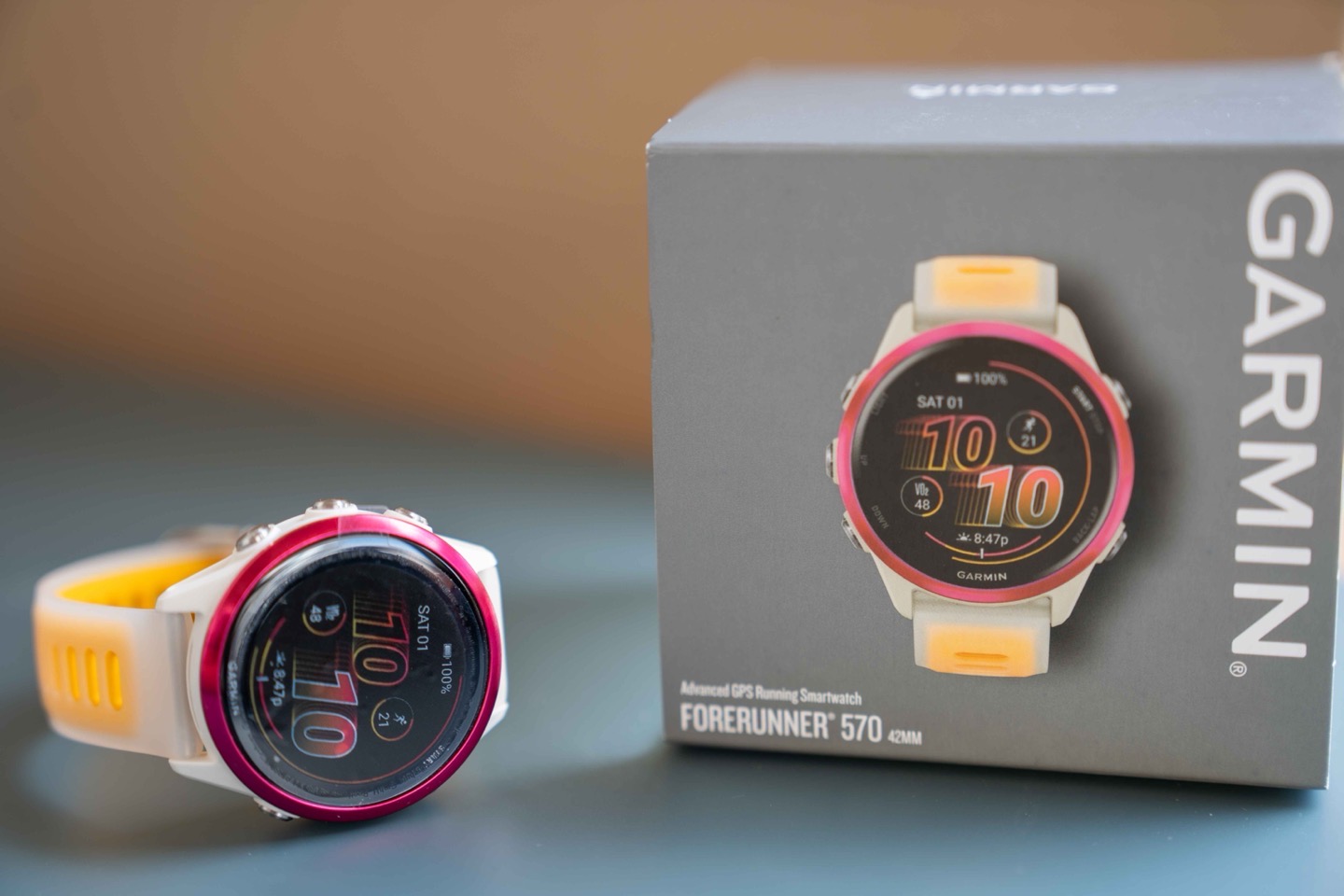
Ok, let’s dive into all the new features on the Forerunner 570, as compared to the Forerunner 265. Oh, and no, don’t expect a MIP-based version here. Gone are the MIP-based Forerunners. You’ll find those in the Fenix and Instinct aisle these days.
In any event, here’s what’s changed:
– Added new Garmin Elevate Gen5 optical HR sensor (but no ECG App)
– Added speaker & microphone for voice calling (with phone)
– Added skin temperature tracking (overnight)
– Added past ovulation estimates
– Added AutoLap by timing gates
– Added Suggested Finish Line estimates
– Added Load Ratio
– Added Projected Race Time predictor
– Added Heat & Altitude Acclimation
– Added Evening Report
– Added Garmin Triathlon Coach training plans
– Added structured multisport/triathlon custom workouts
– Added Focus Modes
– Added Low Battery Alert (e.g. 1 day left)
– Added Large Font UI Option
– Added 23 new sport modes/profiles
– Adds support for up to 4 CIQ data fields concurrently (versus 2 previously)
– Revamped UI to mostly match Fenix 8 new UI styling
– Added aluminum bezel
– Two sizes offered: 42mm & 47mm
– Weighs the same: 42mm is 42g, and 47mm is 47g
– Battery duration went up, and down (see chart below)
– Same 8GB storage as before (with music, as before)
– Price has increased from currently $349 (though MSRP $449) to $549USD
When it comes to new sports profiles, here’s what’s added:
Obstacle Racing, Cyclocross, Gravel Bike, Bike Commute, Bike Tour, BMX, Duathlon, Brick, Pool Triathlon, Mobility, Rucking, Golf, Mountaineering, Fish, Hunt, Horseback, Disc Golf, Snowshoe, Snowmobile, Kayak, Snorkel, Boat, Sail
When it comes to the battery front, here’s how things shake out for the 47mm edition:
Smartwatch mode: Up to 11 days (FR265 was 13 days)
GPS-Only GNSS mode: Up to 18 hours (FR265 was 20 hours)
SatIQ (AutoSelect) GNSS mode: Up to 16 hours (FR265 was 16 hours)
All-Systems GNSS mode + Multi-Band: Up to 14 hours (FR265 was 14 hours)
GPS-Only GNSS mode with music: Up to 9 hours (FR265 was 7 hours)
SatIQ (AutoSelect) GNSS mode with music: Up to 8 hours (FR265 was 6.5 hours)
All-Systems GNSS mode + Multi-Band with music: Up to 8 hours (FR265 was 6 hours)
And, then for the smaller 42 mm-sized unit:
Smartwatch mode: Up to 10 days (FR265S was 15 days)
GPS-Only GNSS mode: Up to 18 hours (FR265S was 24 hours)
SatIQ (AutoSelect) GNSS mode: Up to 14 hours (FR265 was 18 hours)
All-Systems GNSS mode + Multi-Band: Up to 13 hours (FR265s was 15 hours)
GPS-Only GNSS mode with music: Up to 9 hours (FR265S was 7.5 hours)
SatIQ (AutoSelect) GNSS mode with music: Up to 8 hours (FR265 was 7 hours)
All-Systems GNSS mode + Multi-Band with music: Up to 8 hours (FR265 was 6 hours)
Finally, there are a slate of different color options. In this post, I’m showing the 42mm raspberry-mango version, which both my wife and I agree looks great. I’ve also got a 47mm purple one to unbox too. Also, before I knew this was specifically called raspberry mango, in my head I kept calling it the ‘Mango Tango’ version.
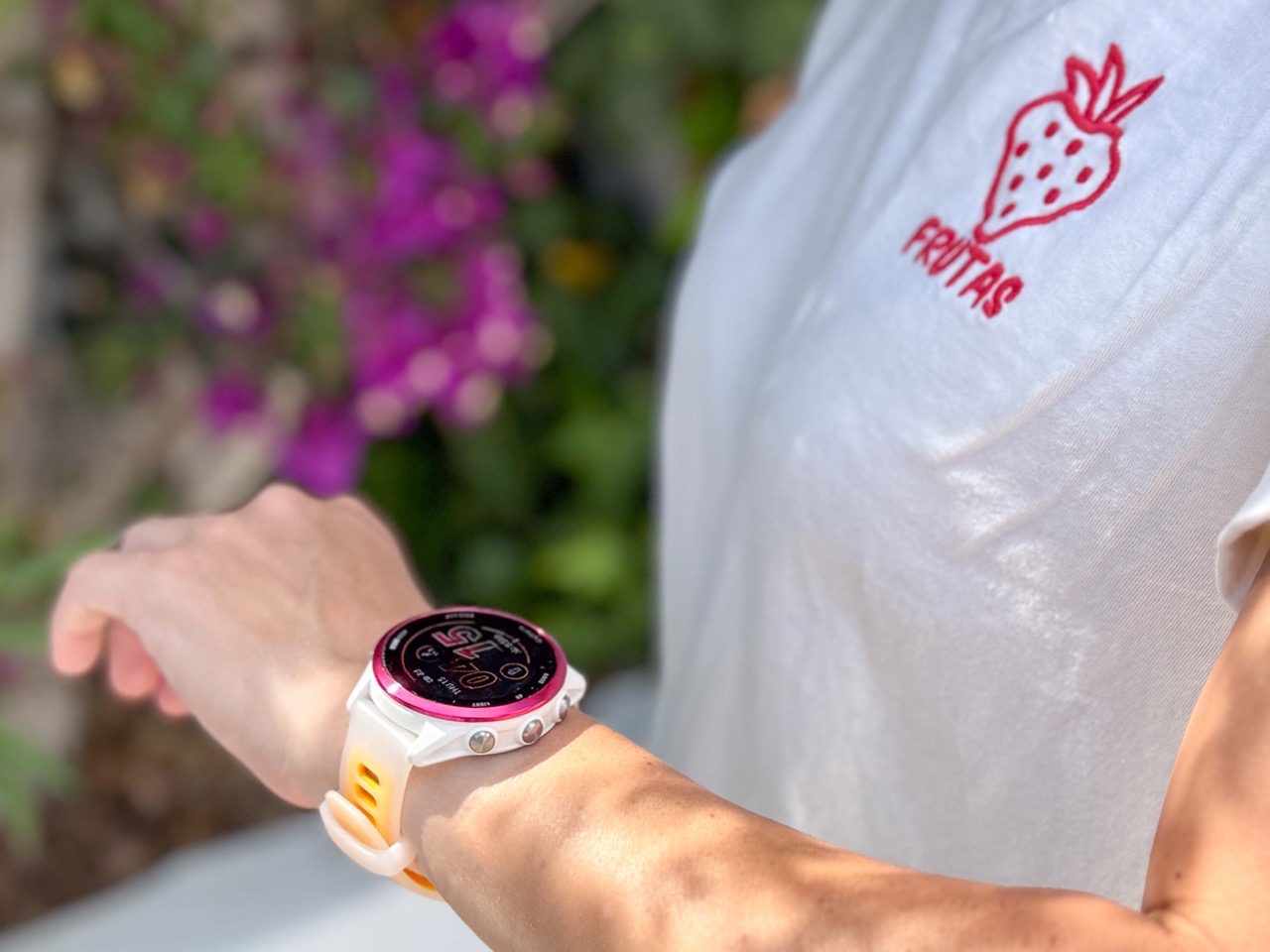
Here’s the 42mm color variants:
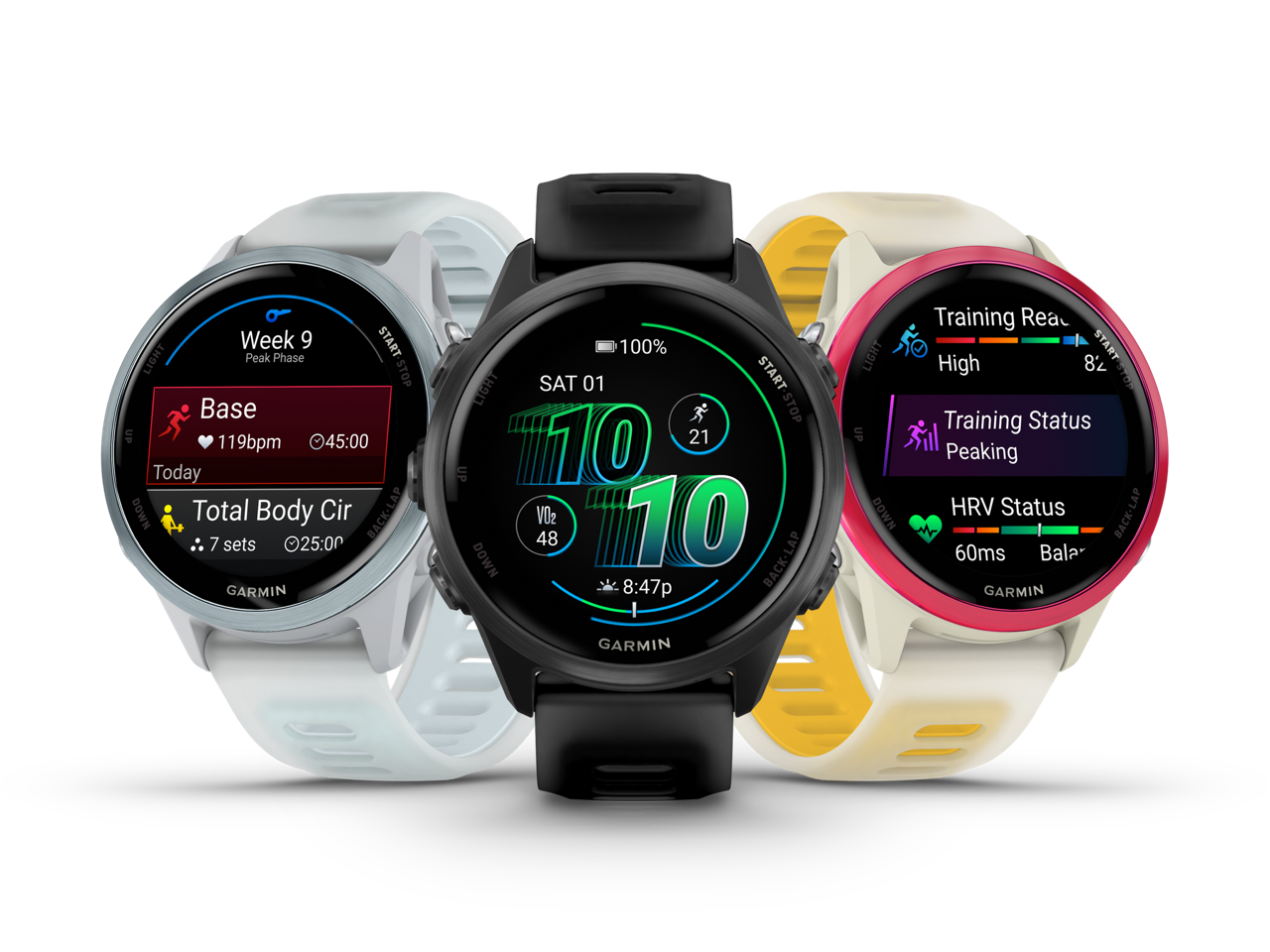
And here’s the 47mm color variants:
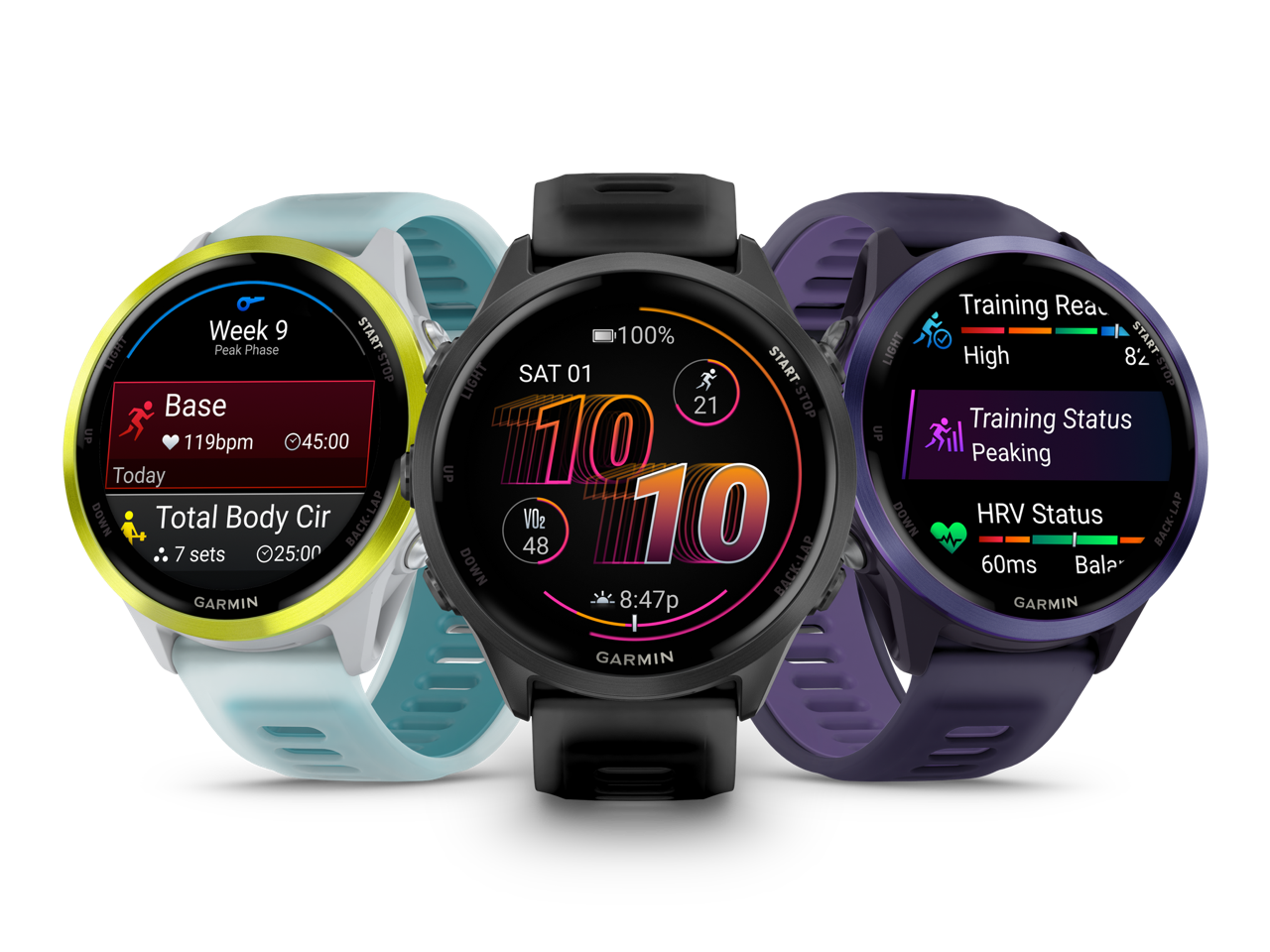
Got all that? Good, let’s look at some of the new features.
A Few Details:
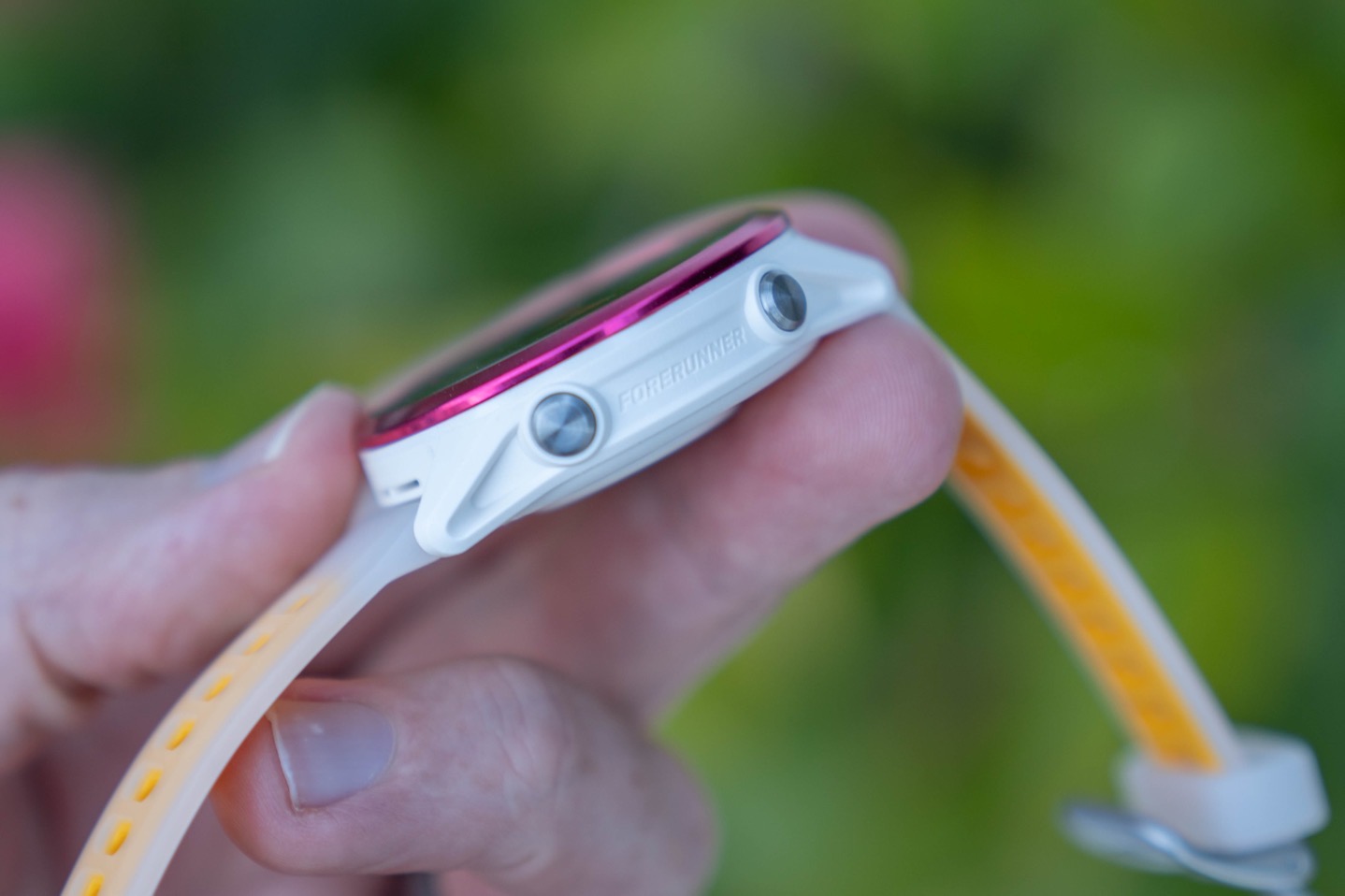
First up, on the back of the unit is the new Gen5 optical HR sensor. That sensor generally gives a bit higher accuracy, especially in harder conditions than the Gen4 sensor in the FR265 (like cold weather intervals or running downhills):
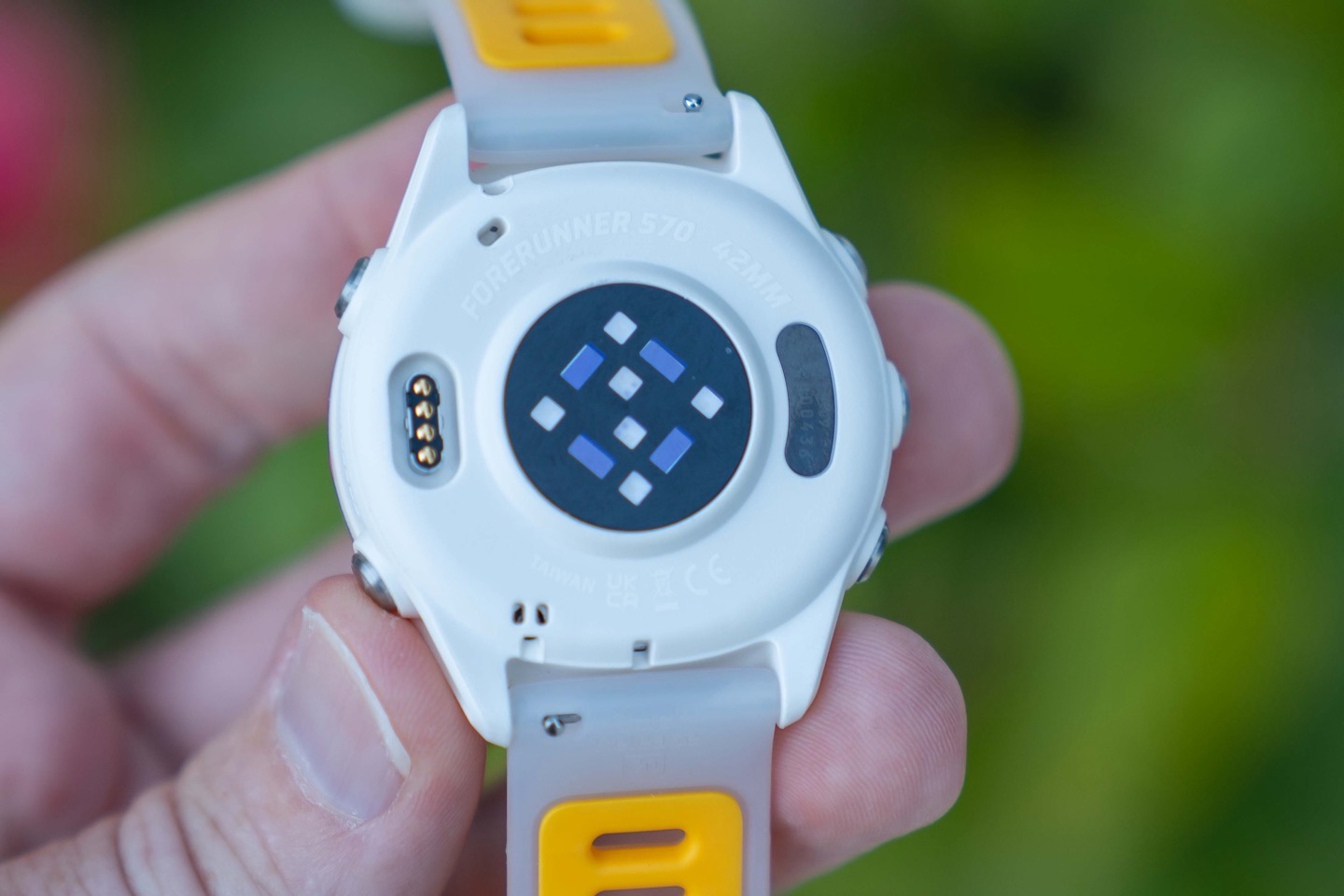
In the case of the Forerunner 570 though, they also add in nightly skin temperature readings. However, bafflingly, Garmin is holding back ECG App connectivity, likely due to lack of metal contacts on the back and connecting wire to the bezel. Whether or not the FR570 has the appropriate hardware to complete the ECG circuit isn’t fully clear, but what is clear is that the Garmin Venu 3 is currently priced at $349 and has ECG support. As does every other Apple, Google, Samsung, and Fitbit wearable below $400. Garmin gives us Training Ratio Load that almost nobody asked for, but oddly skips on the feature that’s heavily requested by many, and included in Garmin’s own cheaper products.
Again, baffling.
Next, let’s look at one of the new running features, which is AutoLap by Timing Gate. This is designed for races, where you’ve got specific mile markers throughout the race. Thus to get started, you’ll create a course in Garmin Connect for the race (or import it), and then you’ll see the option to enable ‘Auto Lap by Timing Gate’ option. When you toggle it, it shows either MI or KM as the metric.
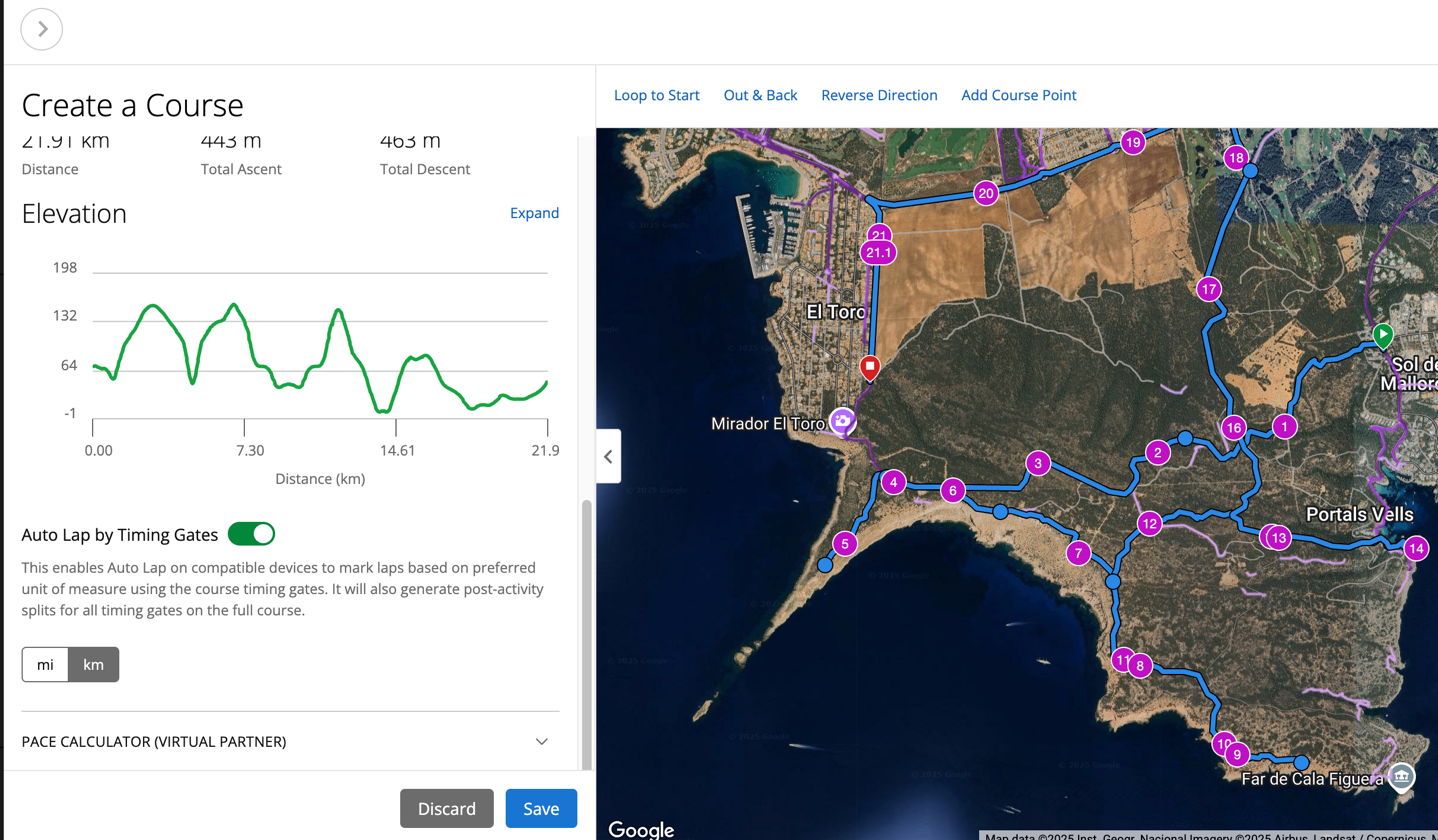
Here it is switching to miles:
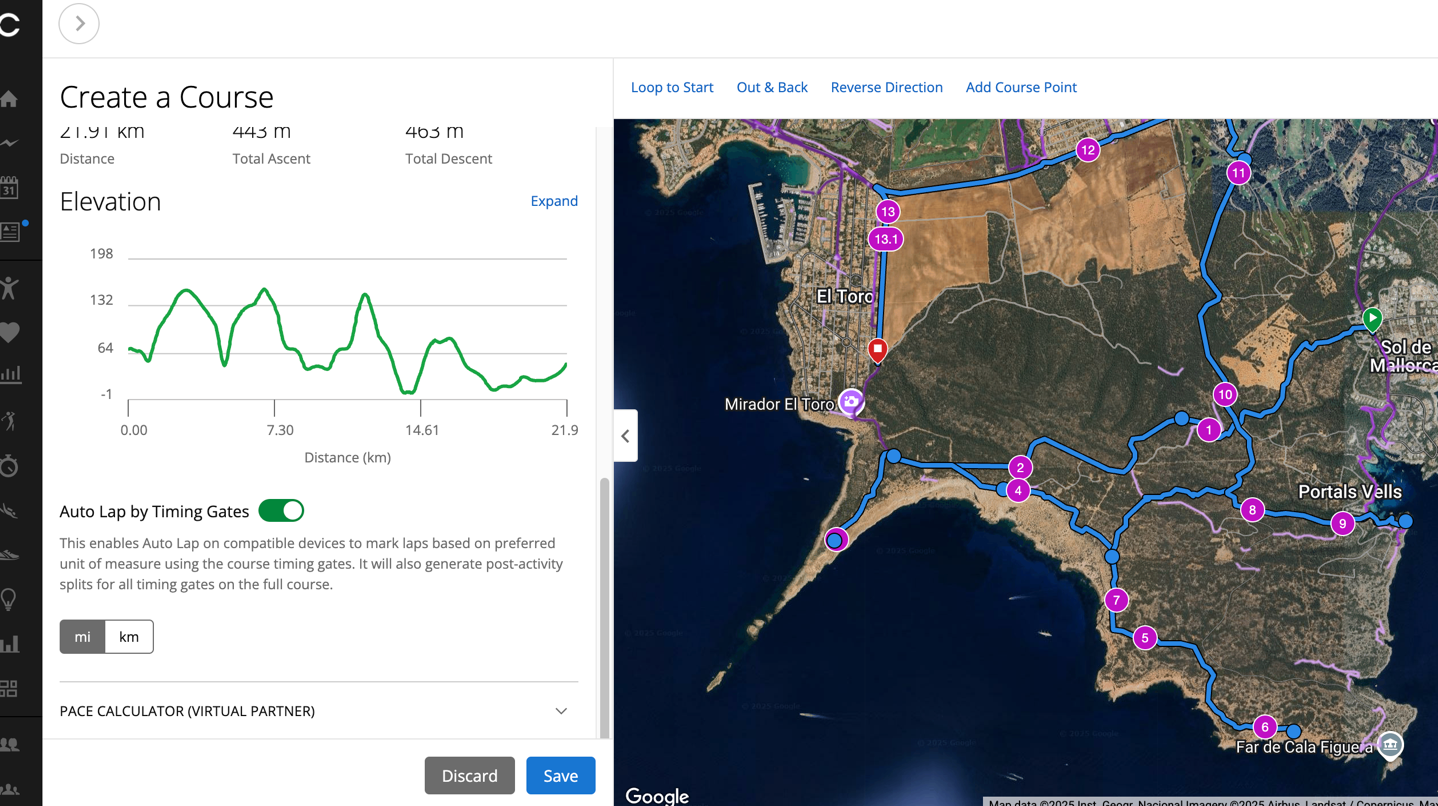
The reason for this is that it’s going to snap your laps to the actual mile markers of the course. This is intended to solve against typical running races where you end up running longer than the measured course distance, due to meandering around people and such. This helps keep your pacing more focused from a lap perspective – as ultimately, the only pace that matters at the end of the day is the timing chip one, not the fake one spent meandering around people.
Either way, I like this concept (kinda like the Suunto concept a few years ago). I’ll need to play with it a bit more to see how it works in real life though.
Next, there’s the ability to create structured multisport workouts:
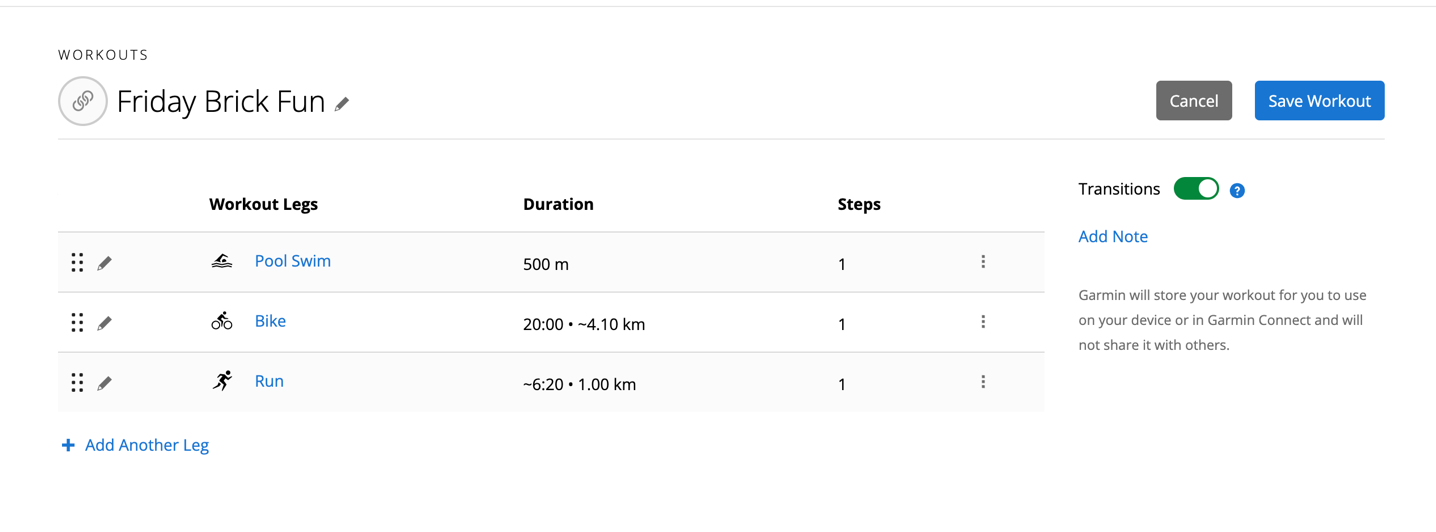
Previously, you could only create single-sport structured workouts, but here you can tie together multiple pieces of suffering with specific per-sport structures.
Likewise, for triathletes, there’s also support for Garmin Coach Triathlon Plans. This allows you to create a triathlon goal race/event, including goal time (if you want), as well as which days you want for your long runs, rest days, and so on. You can even search for specific events (or any triathlons), which will add to your calendar. From there, you’ll get a complete training plan built out, which will dynamically change if life gets real.
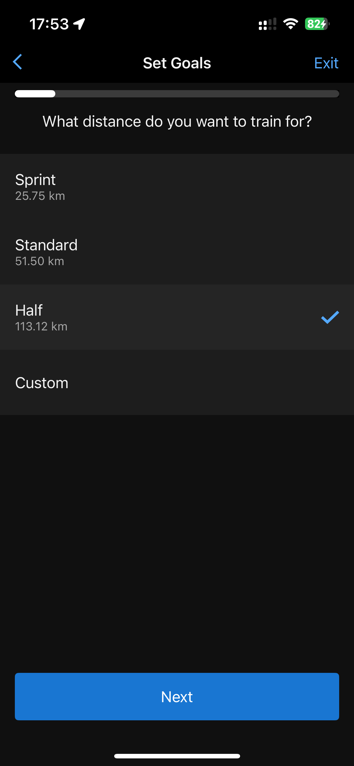


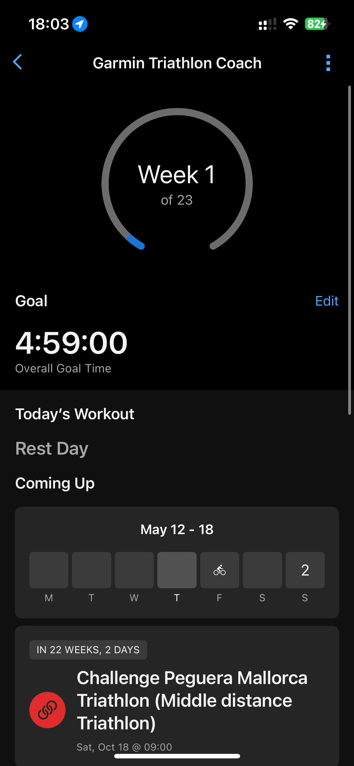
Beyond that, almost all the other features we’ve seen are minor trickle-down features like Training Load Ratio, or increased font size options.
However, the Evening Report is new. This is basically the Morning Report, but inverted. This is different from the Daily Summary feature Garmin has had for a year or two. The evening report pops-up and outlines your day from an activity standpoint, but then focuses on what workouts are scheduled tomorrow, how much sleep you need tonight (Sleep Coach), and more.
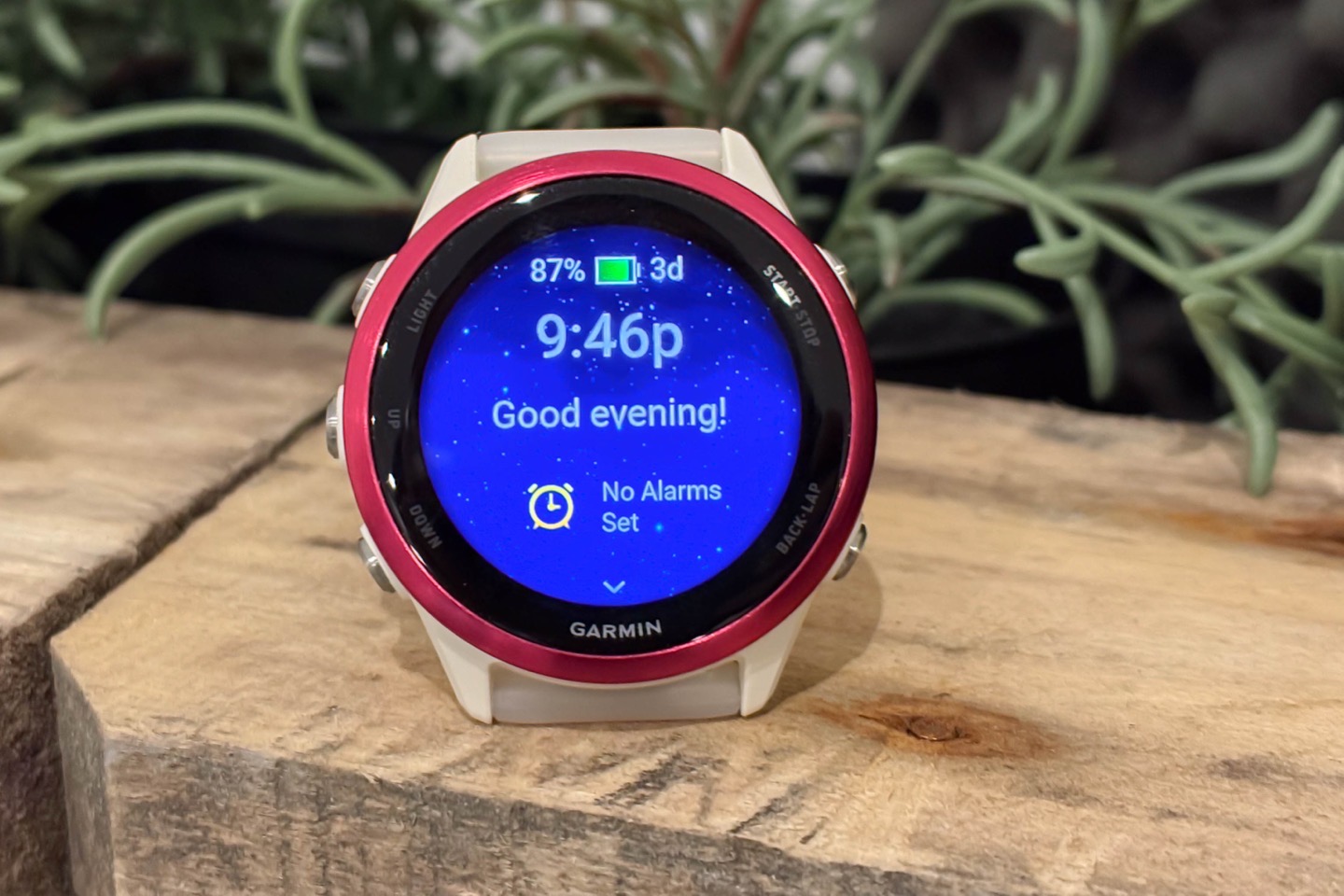
Here are a few bad cell-phone photos from tonight. I’ll do better ones in the future. Also, you can set an alarm directly from this as well:
You can, of course, turn this off, or tweak it. By default, it’ll turn on 1 hour and 30 minutes before your scheduled bedtime. You can also tweak each component too (for example, Jet Lag advisor and Count Downs will show up here too). I do though already wish it had a bit more detail about the training side of things (for example, an option to show training load for the day). Still, I’ll see how I like it, in time for the full in-depth review.
Initial Thoughts:
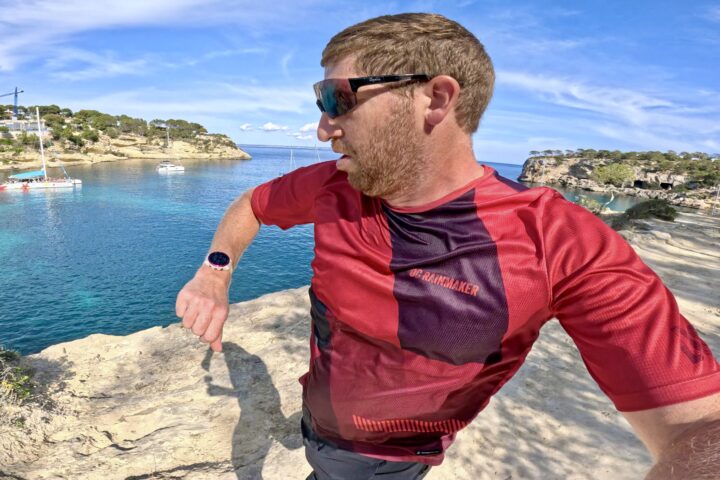
I think Garmin kinda missed here. Specifically, they missed the forest for the trees. Yes, there’s a bunch of sport profiles they added in from other watches, and yes, it got a speaker/microphone. But I’m beyond confused on how Garmin thinks a $550 running watch with trail and ultra running sport profiles shouldn’t have maps (when all of their competitors below this price point do, far below). Garmin appears to believe that their higher quality level and other features in other categories will make up for it.
However, more confusing is the ECG situation. Garmin sells the Venu 3 at $349USD, and that includes ECG. Why is a Gen5-capable watch that is the FR570 at $549 not including it? This watch isn’t competing against the Fenix, it’s competing against an Apple Watch, Samsung Watch, or Google Watch – all of which have ECG (and more advanced ECG) at $399 or less.
Look, I get that tariffs do impact prices, really, I do. But these features were decided well before tariffs came into existence. The unit has the storage for maps, and has the correct optical HR sensor for ECG (whether or not it has the added wire to the metal bezel required for ECG isn’t known).
Setting those frustrations aside, my initial trail run with it was good. The screen is easily visible in the bright summer-like light, and the accuracy of the heart rate and GPS is also solid (as expected). Likewise, I really do like the styling of this particular unit I have. It’s awesome, and shows Garmin coming out of their shell a little bit here. I also like that Garmin appears to be consolidating some of their different user interfaces this year, continuing with the FR570 and FR970. Hopefully, that trend continues.
With that, thanks for reading, and stay tuned for the full in-depth review down the road.
Found This Post Useful? Support The Site!
Hopefully you found this review/post useful. At the end of the day, I’m an athlete just like you looking for the most detail possible on a new purchase – so my review is written from the standpoint of how I used the device. The reviews generally take a lot of hours to put together, so it’s a fair bit of work (and labor of love). As you probably noticed by looking below, I also take time to answer all the questions posted in the comments – and there’s quite a bit of detail in there as well.
If you're shopping for the Garmin Forerunner 570 or any other accessory items, please consider using the affiliate links below! As an Amazon Associate I earn from qualifying purchases. It doesn’t cost you anything extra, but your purchases help support this website a lot.
And finally, here’s a handy list of accessories that work well with this unit (and some that I showed in the review). Given the unit pairs with ANT+ & Bluetooth Smart sensors, you can use just about anything though.
And of course – you can always sign-up to be a DCR Supporter! That gets you an ad-free DCR, access to the DCR Quarantine Corner video series packed with behind the scenes tidbits...and it also makes you awesome. And being awesome is what it’s all about!
Thanks for reading! And as always, feel free to post comments or questions in the comments section below, I’ll be happy to try and answer them as quickly as possible. And lastly, if you felt this review was useful – I always appreciate feedback in the comments below. Thanks!




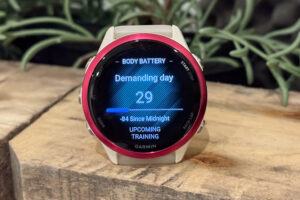

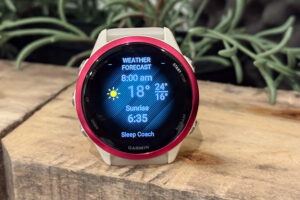
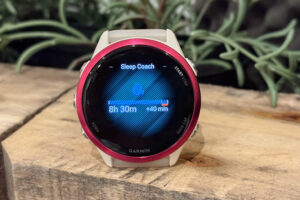
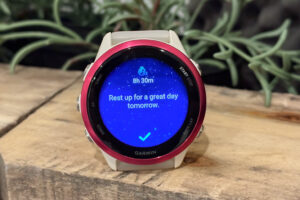
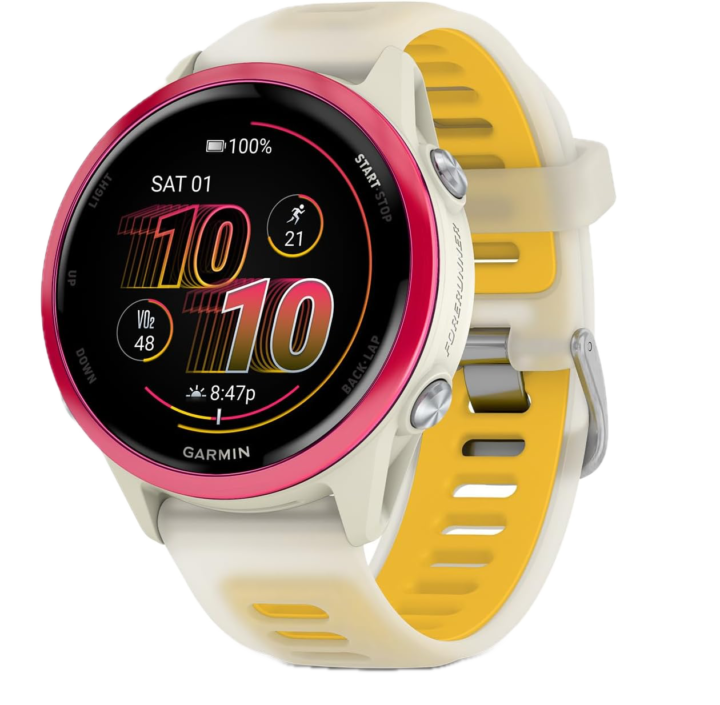
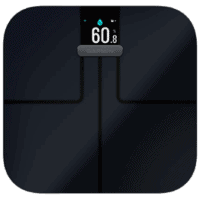
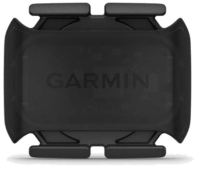
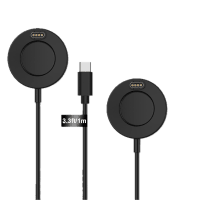

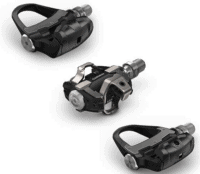
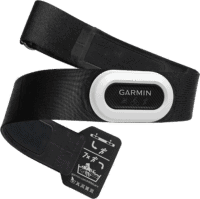
















The ecg thing make no sense to me. Unless they are specifically doing it to push you up to the 970.
It does however make choosing a new watch trickier. I bet they do a venu 4 just after I buy this, or the vivoactive 6
> It does however make choosing a new watch trickier.
Exactly. Garmin consistently appears to intentionally create a confusing pricing ladder to push consumers higher up it.
I agree that it does not make sense at the price point and must be to push customers to the 970.
570 does not seem have the hardware though. You can clearly see it missing the metallic fields on the sensor, so I assume it is more than a missing wire.
What makes even less sense is the importance given to the ECG while it is a niche function. If you are under 65 and have no health problems (hypertension, obesity, diabetes, heart failure), the main utility of the ECG is to make false positives and raise anxiety unnecessarily.
For the vast majority of Garmin users, it is not even a useless function but sometimes even a negative one.
I was going to argue that 65-79 year-olds are still a significant part of the population, but a Duckduckgo search shows that they form only 13% of the US population. I will say that ECG was the main feature I was waiting for, so I guess I’ll just stick with my 265 for now. Meanwhile, the short battery life of the Apple watch makes it the least marketable for me.
The problem is that the Venu and Vivoactive series never get any updates (you can check at Garmin forums). I am a Venu 3 user and the watch has received only 1, I repeat just 1 proper update and that was immediately after they launched (the update that included Running Dynamics). After that every update was just bug fixes and not a single feature. Garmin is definitely losing it all. Venu 3 was their best smartwatch when launched and it still cannot set Weather to any random location. I was traveling recently and I had to connect to Wi-Fi and then turn on the Bluetooth for the watch to detect my new location and provide me the weather for that. For a 450$, Venu 3 is total trash and I would definitely not recommend any Venu series if it is above 350 or 400$. Hell yeah the 299$ FR165 gets more updates than the 449$ Venu 3, which just feels like a slap on the face of all Venu 3 users. These are my opinions and I have shared them many times on Garmin forums and others have shared too, but Garmin is just ignoring the Venu 3 users. I guess this will be my last Garmin watch (been in Garmin family since 2017).
Why focus on the U.S.? Garmin operates internationally. Due to the poor healthcare system—set to decline further under this administration—and unhealthy lifestyle habits compared to Japan and Europe, the U.S. has fewer people aged 65 and older. Life expectancy is also significantly lower.
Amen my friend
$800 here in Canada….while we can get a 965 for less. And a 265 for half that….LOL Garmin is drunk.
I was holding off on a 265 to see what Garmin released. Seems like I should grab a 265 for a great price before they are all gone.
Why it has a worse battery than fr265?
Doesn’t make sense. It should be at least equal.
As someone who wants more features than the VA6, but not as much as the FR570, I’m concerned about a new Venu. The altimeter is shot on mine, (thanks chlorine and pool swimming) and out of warranty, so I was hoping for the 4 to come out in order to justify getting a new watch. Now I’m afraid the Venu line is:
1. Dead and the 3 is the last one, or
2. Even more obscene as far as price is concerned. The 3 is on sale now, but the base price has increased by 60 dollars since it was released in 2023 (659.99 vs 599.99).
Also, most of my accessories are 18mm and most of the watches want 20mm or 22mm straps.
This is always the case with Garmin : at the launch of a new model, we can have the previous one with a big discount. Epix Pro after the launch of Fenix 8, Enduro 2 after the launch of Enduro 3, and so on…
So if you want to have a good product at a good price, nothing new under the sun : get the old model!
After years of loyal services my 750xt has finally bitten the dust though and despite being a regular reader of this site I have no idea what to go for- I find this argument really interesting because the tech has come on to the extent that I have no idea what to go for. My 750xt just worked, but I’m 36 and coming back to tri post (2x) partum and I feel like I’m one of those 65+ year olds baffled by the world and its changes!
I don’t care about ECG nor about maps but I do care very much about heart rate so this would be the perfect running unit for me…if it were priced $200 less. I am not stupid though and I ain’t paying $550 for a crimped watch.
Garmin shouldn’t be gimping devices in software. It’s baffling that they don’t have maps or ECG when the hardware can do it. Artificial segmentation is a sign that management thinks their customers are very sticky and their primary competition is themselves.
Garmin has been doing this for years with portables (auto) and handhelds. Nuvi, Etrex, and GpsMapXYZ all had different sw feature limitations all within their respective product lines. It’s in their product marketing DNA.
Even Apple reserves certain software-only features for the most expensive models – just not to the same extent as Garmin. See: “precision start” in the Workouts app, which is only available in Apple Watch Ultra. It’s simply the ability to manually start an activity , instead of having the activity automatically start after a countdown as soon as you select a sport. AKA functionality that Garmin and other sports watches have had for 10+ years.
Ofc Apple doesn’t have nearly as many models as Garmin, either.
I really don’t understand why so many people consider software limitations to be “artificial” yet somehow hardware limitations are ok? Both kinds of limitations are a deliberate attempt at market segmentation. Do people think software is somehow less “real” than hardware? Software still costs money to develop and test. And you’re not just paying for parts on the bill of materials, you’re paying for the software development, marketing, R & D, and all the other stuff that goes into making a product.
Would it be ok for Garmin to exclude maps from 570 if Garmin also had much less storage on the watch? Perhaps 512 MB instead of 8 GB? What if Garmin used some super special encryption on their maps which requires a hardware chip for decryption? Would it then be ok to exclude maps on the basis that the decryption chip is not present?
Is it ok to exclude ECG from 570 if it’s true that 570 is missing some metal wire that makes it possible? A piece of wire is hardware, not software. Does it really matter if the wire is there or not, so long as Garmin says ECG is not supported?
Besides, not all hardware limitations/differences are as “natural” as we might think.
– When a certain model of CPU/GPU fails a certain manufacturing test, it’s often sold as a cheaper, slower version of the chip. iow, a cheaper CPU may very well be a defective instance of a more expensive CPU
– Some consumer-grade GPUs are simply software-locked versions of a more expensive professional-grade GPU. This is made clear by the existence of driver hacks to unlock the pro features
Ofc if we really believed it’s not right to make “artificial” limitations on software, then:
– it would be impossible to sell different versions of Windows
– all video game DLC would be banned (ofc back in the day, there was a huge controversy about console video game DLC that was shipped on game disc, and when you actually bought the DLC, it just unlocked the digital bits that you “already had”)
– in-app purchases would also be banned
I just don’t understand this mindset of “hardware limitations good, software limitations bad”, or in general, the idea that companies should be charging a “fair price” for their hardware (that’s somehow based on price of the parts). I’ve even seen this with my own co-workers, back when I worked in embedded systems. A co-worker would look at some competitor’s offerings and say “these prices are unfair!!! their model with 10 widgets costs 3X as much as their model with 5 widgets. it should only be twice as much.” The irony was that our own products were priced similarly, but he couldn’t see that.
To be clear, I am not saying customers don’t have a right to criticize Garmin for:
– exorbitant prices
– a confusing hardware line up where sometimes you can’t get all the features you want even if you buy the most expensive model in your category (e.g. the most expensive Vivo/Venu model doesn’t have all the features of a midrange Forerunner), and where customers are nudged to buy the most expensive model even if they don’t need it
– excluding features that people want from expensive devices
I’m just saying I don’t think it makes sense to criticize any of that on the basis of “hardware limitations good, software limitations bad”.
I’m sure everyone who works in any tech industry where multiple versions of the same hardware are produced knows how these models are designed: first the most expensive model is specced out, then marketing systematically removes features to create lower-priced models.
In other words, all differences between models are “artificial”. Garmin decided which hardware to put in the 570 and they decided which software to put in the 570. Unless Garmin promised you that the 570 could run any arbitrary software you want (like a PC or even a general purpose smartphone/smartwatch), I don’t really see any cause to complain *on the basis of “artificial” software limitations*.
If you wanna say the 570 is overpriced, and that we should be getting maps for that price, I’m with you. No one is obligated to buy a 570 or a Garmin tho.
As a counterexample, some would say that Apple charges an exorbitant markup for RAM on their phones and macbooks, and this is especially egregious because the RAM on their macbooks is soldered to the motherboard, so end users can’t easily perform a DIY upgrade.
Is this kind of price gouging somehow more acceptable than price gouging based on software differences?
To be clear, I really think many people (including those who work in the tech industry) have this implicit assumption that when they buy something like an Apple Watch or Garmin, they are “paying for the hardware” and “getting the software for free”.
With this mindset, it kinda makes sense that customers would expect to get all the software features that the hardware can handle.
But actually, it doesn’t work that way, and anyone who’s been following Garmin for more than 5 minutes has probably noticed that Garmin goes hard in the other direction: they absolutely segment the market with difference in software features, including stuff that doesn’t even make it on to the spec sheet.
That’s why the Garmin forums are full of threads like “petition to bring hotkeys to 165 (we really want this feature)”, “will [last-gen Garmin device] get [new feature from newly announced Garmin]????”, etc.
I mean, the answer in almost every case is: no, Garmin isn’t gonna give you that extra feature you want via a software update, they know you want that feature and they expect you to pay more money for it by buying a new device.
Don’t really see how people expect Garmin to change now after 20-ish years of doing the same thing. It may very well be Garmin’s undoing, as implied by this comment:
> Artificial segmentation is a sign that management thinks their customers are very sticky and their primary competition is themselves.
But I don’t see Garmin changing this strategy any time soon.
Can I just ask why you collaborate in this $0.99 speak? You don’t work for their marketing department, why not call a spade a spade and call out $349 price as $350, or $399 as $400. It’s not as if most people pay this price anyway as you have to add tax in the US too.
When I list prices, I specify the actual price. When I’m talking more casually, as I did in the end of the post, I use the close-enough prices.
Nobody in the history of this site in 15+ years has complained before at that balance.
Well, the actual price is $549.99 on Garmin’s site and you round it down $1 instead of up 1c…
Seriously…?
Is there any word on what may make it as software update to older phones? For a while it looked like Garmin was getting better, but looking at the list of sports – no reason not to bring them to 255/265.
Most surprising is the addition of sailing. For years only the higher water resistance watches were considered for boating activities. Garmin specifically mentioned 10 ATM for high speed water activities, and 5 ATM didn’t get boating profiles. Is the 570 rated 5 or 10 ATM?
I would be interested to know how the 570 feels on the wrist compared to the 265. My 265 is the most comfortable watch I’ve worn over the years so I wouldn’t trade comfort for all the new features (most of which I would likely never use).
And now they offer a worse battery which is incomprehensible
Their old MIP watches lasted forever. This new strategy actually makes perfect business sense.
I’m really quite confused by everyone talking about the worse battery life. Doesn’t it have much better battery life with music? In the battery life times listed above, it seems to give 1 – 2 hours more during GPS activities with music, so shouldn’t it overall balance out with the 265, especially if one’s playing music outside of activities?
Quite expensive for such a watch. I guess their old 255/955 and 265/965 will sell like hotcakes now, especially with discounted prices or on the second hand market. As for the colors, on one hand I kinda like the options too, on the other hand are they a bit too gaudy for a more professional attire…unless you are a sportstech influencer or clown….no disrespect!!
What really surprised me, was that Garmin videos were o0n YT long before you and Des and the others posted their stuff, is their a change how Garmin handles new product launches?
I thouht the same! my tri friend shared the device, I went to youtube and there were no DC, Des, Chase, Matt videos.. WTF? Is garmin trying to get the ad sense revenue before you guys? :D
Yeah it looks cool, but these watches are meant to be used 24/7, and $550 and $750, the person buying them is likely to be some personal with a formal job, not someone in the clown business.
Garmin does not have a single watch that is appropriate for “formal job” setting…
Pfft…have you seen the Bounce?
Forgot about that one! And the only Garmin with real LTE/data service.
Bounce definitely has boardroom cred…or was that boardgame haha
I used to get excited with every Garmin release, whether it was an entry level or a high end, I wanted to have them all. I only replace watches when they die but I always looked forward to what was coming.
Now, I’ve never been less excited about new releases. If my Epix Gen 2 dies, I’d just replace it with the same model since it’s always on sale or maybe the Epix pro. There’s nothing about the newer models that make me want to pay the additional hundreds of dollars over the Epix. It seems like Garmin peaked in the Epix Pro.
Garmin really needs to add maps to EVERY WATCH.
Is the screen same as fr265?
The timing must have been planned. I see Huawei released some new models today. Or maybe it’s the other way around.
Oh, that’s interesting about Huawei. I find myself more interested in that than this (given what “this” translated to!), so will go and see what they’ve said
I’m very over Garmin, partly for all the madness that is the spec list here, partly due to that cost bump (I wonder how that translates in a tariff-free environment), but also self-imposed after they tried to deny my GBP 7 worth of tax on a watch I bought for my daughter. A lot of toing and froing over that (like hours wasted, but I wasn’t going to let it go as a Garmin rep told me the VAT would be refunded (I live in a VAT-free UK-adjacent country)), and as a result I’m not buying Garmin.
The feature spec reminds me of Canon cameras – a brand I also have but will move aware from due to behaviour that can only be described as petty (and I would also call Garmin’s “segmentation” petty)
I’d love to see the difference in popularity for the different colours. I cant believe that enough people go for some of these garish (in my opinion) options to make it worthwhile for Garmin to be making them. I’m a boring black, my partner might go for another colour, but still solid. The multi colour options look cool but I’d not choose them for something I’m wearing pretty much 24/7
Would be interesting to see how the coloured options sell compared to the black/white
I am a boring black too or perhaps dark grey, while my wife likes white or light grey. I also wear my clock 24/7 and like neutral colors then.
For activities I could well like a more colorful expression, but would prefer to add it with a strap/band.
The accents messes up, both with neutral bands and also crashing with many colored ones. Fenix 8 is similar with some versions having colorful accents instead of matching the bezel. They look great with the matching band, but not if switching to a different colored or neutral band.
This was both for 570 and 970, with the accents applying to 970. The raspberry, yellow and purple bezels on 570 is also a no go. Colorful bands are nice though.
Niche colors can be perfectly worthwhile for the company if the buyers of the night color happen to be buyers who would not have bought the mainstream color but from a competitor, or not bought at all.
Contrast this with “slightly different but still mostly mainstream” colors, even when those are kind of successful, it’s perfectly possible that every single buyer of those would have picked some even more mainstream standard color instead.
Rising prices and no offline maps.
Not bad Garmin:D
I hope Suunto’s and Polar’s sales increase a lot!
“Look, I get that tariffs do impact prices, really, I do.”
Suunto Run says hi ;)
Ironically, Suunto/Apple are in a slightly better spot here. The tariffs on goods from China have a cutout for smartwatches & phones. Said cutout doesn’t exist for goods from Taiwan. Go figure.
“whether or not it has the added wire to the metal bezel required for ECG isn’t known”
Clearly this variant of Elevate 5 does not have the metal contact surfaces that would be the counterpart to the bezel, so there’s no point in wondering about the presence of a wire? There’s no ECG, period.
Interesting. I’ve worn the Forerunner 200 series since the early years and still use the 255s. But I swap out the band to an elastic one that doesn’t have a buckle digging into my wrist when I sleep or sliding around when it’s wet. I wish Garmin offered more wristband options.
So, if I’m a runner (road, trail, track, treadmill) who occasionally bikes, XC skis, walks, and swims; and I’m looking for ECG capability and most smartphone functions (microphone not necessary), would I be better off with the Venu 3 than the FR 570?
I don’t follow Garmin closely, but I find those watches number terrible confusing
The shift from 2xx to 5xx makes sense though: after so many features have trickled down to the 2xx line, there’s more room in the portfolio for a truly lean running watch below the 570 than there would be room between 570 and 970. Something with an HRM, a high contrast screen like the solar Instincts and the bare minimum of battery to make it through a “barely faster than walking” marathon. An Edge 130, but for running.
I would have preferred an Edge 140. A successor to the Edge 130 has been a long time coming and Garmin doesn’t have a current small/light bike computer in its range.
That would be great! My girlfriend put her 130 in the washing machine. Although it is still sort of working, it soon will need a replacement and a small unit fits really nicely between the aerobars….
Not bad, but as typical Garmin, only the software bugs are corrected in the first 2-3 years
It’s funny and distressing at the same time how some people seem to take Garmin and other watch release kind of personal. Garmin dropped two new watches and yes, compared to other manufactures out there they lack with key features like map … but hey, buy it or don’t buy it, it’s that simple. Don’t take it personal.
I have a Garmin Forerunner 265 and caught myself with the idea to buy one of the new ones because of some training features, mainly the triathlon. Now, after sleeping one night, my head is free again and of course I will not upgrade. Simply because my current one works and I do not do better sport with a better watch and I do not finish any triathlon just with some features from any sport watch … it’s me, myself who has to go out there and train, not Garmin, not Apple, not Amazfit … and now I will go for a run, even without maps, cause I have eyes and a brain :-)
I was looking forward to this watch release, after initial reviews it’s a bit disappointing – no maps? Is there a reason to not get the 965 that is now on sale for $499 or even the Epix Pro Gen 2 for around $550 on Amazon over the 570?
This has the newish Elevate5 heart rate sensor whereas the 965 has the older version.
Fair point, but the Epix Pro Gen 2 has the Elevate5 (and ECG not that I would need that)
So why would you choose this over a venu 3, when the 3 is cheaper and has better battery specs? Garmin has lost the plot
Because Garmin reserves certain “running-specific” features for Forerunner, Fenix and related watches [*], such as training load and training readiness.
[*] And they make sure to never put these features in Venu or Vivoactive watches, which are marketed as “lifestyle” watches.
Sure, you can say that runners don’t need those features, but there’s a reason topics like “why doesn’t venu 3 have training load???” pop up in the forums every now and then.
To be clear I’m not defending Garmin’s behaviour, just pointing out what they do. As others have pointed out, it seems Garmin deliberately makes their product offerings confusing, in order to encourage customers to buy the most expensive watch.
Ofc it doesn’t help that sometimes even buying the most expensive “lifestyle” watch doesn’t get you a certain feature which is available in a cheaper “running” watch.
How can Garmin release a watch almost a year after Suunto Race S and lose on so many levels?
I am in what I think is a super small minority here but they added almost all the major golf data/metrics/etc which was completely absent from the 265. This is an instant buy for me as someone with smaller wrists that could never get comfortable with the 47mm size. You usually list the golf features in your reviews as Garmin is becoming a major player in that space with their new R50 launch monitor. Hope you add a blurb about them adding the golf stuff so people know.
And still no dancing profile. Many amateur dancers also run, what is so hard in adding that sport profile. Polar has this for ages.
These deliberate omissions (EVG, maps, etc.) seem to me like catering to internal silos (e.g., Venu vs. Forerunner teams) rather than to customer needs. I know Garmin still has a better overall lineup than Apple for sports, but I’m starting to lose my enthusiasm for the company (Garmin) itself.
I am one more nudge away from switching to Apple, especially considering that Stryd software and hardware seem to pair better with Apple Watch than with Garmin (a pain in my experience)
No maps? Non starter. Good luck!
autolap by timing gate is a feature that seems difficult to use *(uploading a course is not as easy, as they are often not available) . Also i don’t see the point of this feature as mental arithmetic is easier. Just looking at your average pace at the time gate will be sufficient to calculate your predicted finish time or to calculate how much faster you should run
They need new features (as useless as they may be) to justify new products and price jumps.
I agree, it seems overly complicated. I would have much preferred simply a race-by-lap mode, akin to this Connecf IQ app: link to dcrainmaker.com
Do you think the 570 with get the ECG app unlocked? If so, when?
No, it doesn’t appear to have the right hardware for it.
Hi,
My initial thought: quite expensive. but sounds like a great watch.
I have two questions:
1) Will we see a cheaper version, for exemple a FR 170 or FR70?
2) how many of these feature will be lock behind Garmin connect+?
Cheers
Raphaël
No MIP option, curved displays, worse battery, microphone :-\
Are these Forerunners actually for runners anymore?
I completely agree with you.I think Garmin got a bit lost here. Specifically — they lost sight of the bigger picture by focusing too much on the details. Yes, they added some sport profiles known from other watches, and yes, there’s now a speaker and microphone. But I honestly can’t understand how Garmin thinks that a $550 running watch with trail and ultra running profiles shouldn’t include maps — especially when all competitors offer maps in watches that are significantly cheaper. Garmin seems to assume that their higher build quality and other features will make up for this omission.
So high price for a smartwatch without maps is scandalous.
I’m currently looking to get my first Garmin after years of wearing an Apple Watch. Would it be good to get the Forerunner 570 or another model, such as the 965, 265, or even 255? I am running 40-50 miles a week and am going to begin triathlon training soon
If you don’t need maps and not fussed about smoked (MIP is actually far better for pure runners IMO) the 255 is still a great choice at a great price.
> MIP is actually far better for pure runners IMO
Yeah the reason I like MIP is it’s instantly glanceable.
1) In bright sunlight, no backlight is necessary, so you can just glance at your watch without doing a deliberate wrist turn gesture and waiting for the display to light up
2) At night time, you can set the backlight to stay on indefinitely during an activity (at the expense of battery life), so the display is still instantly glanceable. In contrast, Garmin won’t allow AMOLED devices to stay at full brightness indefinitely.
It doesn’t help that Garmin is bad at detecting the gesture, compared to Apple (for example). This is one of the reasons that I’m not fully convinced by the argument that turning your wrist is ok bc Apple users are used to it. Apple users are also used to a far better UX than anything Garmin ever puts out.
Ofc lots of runners don’t look at their watches while they run, and MIP looks terrible indoors (as well as having a a very limited colour palette and refresh rate, making it bad for things like videos, maps, and nice UIs), so it’s unsurprising that MIP lost the marketing wars. Garmin tried to make a case for MIP for many years, going so far as to create a marketing page which said MIP performs great in sunlight and lacks distracting colour and brightness. Ofc now they are using colour and brightness as a selling point for AMOLED.
Since Garmin obviously failed to convince the majority of ppl that MIP performs better in sunlight, the only remaining selling point is battery life, and Garmin already solved the AMOLED battery life issue for the Forerunner line.
It does say a lot that Garmin hasn’t brought AMOLED to Edge devices tho, where there’s no gesture, and it’s sometimes impractical for the user to press a button to make the screen light up.
I don’t think Garmin sees worse battery life as a bad thing to be honest. And now that they compete with Apple they can afford to make newer watches with far worse battery life as long as they remain much better than anything Apple offers.
I guess the older models are still well worth considering. For instance, if you are happy with a MIP Display, you could go for a Forerunner 955 or a Fenix series watch. At their current price point, they have plenty of features and as you (probably) ramp up your training for triathlon, you could probably profit from the great map and navigation features at a reasonable price. I use the Fenix 7pro (and plan on staying with it for a while) for triathlon and trail running and am quite satisfied.
Thanks for your initial thoughts! I have have a Forerunner 245, and I’d like to upgrade at some points. I am mostly just a runner/coach. Any thoughts/recommendations for a new unit?
245 to 255 is a big step up. Speaking as a runner, the 265 and 570 have nothing useful that the 255 doesn’t have.
I have looked to see if this has the smart alarm functions that has just appeared in the Vivoactive 6. Is this something that is intended more for a different user type, or did I miss it in the text?
My wife really want the 570 mostly for the size and for the colour, she has my old 955 but she don’t like the look of it,
I have a question for anyone that has the watch, if I read the article of Ray he say that the watch has Heat & Altitude Acclimation. But on the official garmin website they say that is not on the 570. Who is right?
Check the user manual. The Garmin website is often out of date as new features are added.
I just wish I could get quick release straps (bc more options), a smaller size, and full maps in a garmin. Ive been trying FR 965 but I think I will be returning. I cant find a comfortable band that isnt a pain to change or ugly and bulky. But I am not sure the 265 S is worth switching from apple without full mapping… these 570s are beautiful. I really hoped this would be the in between where I could get a smaller size and maps but sadly with price I dont much more than 266
Looks like a nice watch. I would prefer having the flashlight instead of the speaker. To get that I’d have to buy the more expensive 970, which isn’t available in a smaller size.
Thanks for posting this. I purchased a 255 Forerunner about 2.5 years ago, and it works fine despite its shortcomings, so I think I will carry on with it for at least 1-2 more years since the cost of these new ones, without much improvement, doesn’t support the investment. Sure, in a few years the next level will cost even more, but I’d rather get 4-5 years out of my watches rather than trading out every 2 or so.
I read with bemusement about all these new sports activities that Garmin supports. They would be better served improving the ones they already have with more accurate data and a better understanding of things beyond just cycling and running. Their ability to judge aerobic, high and low, anaerobic is just awful in indoor rowing, and its clear that they not only don’t know, but they don’t care either. Why can’t we get Vo2 max data beyond running and cycling?
If you were to tell me in a detailed review that their sleep scoring, body battery and HRV metrics are improved, that might be of interest and get me to shorten my purchase cycles.
“If you were to tell me in a detailed review that their sleep scoring, body battery and HRV metrics are improved, that might be of interest and get me to shorten my purchase cycles.”
In terms of all those metrics, coming from a FR255, they will be identical.
There will be slight under the covers sensor improves from Gen 4 to Gen 5, but most of those improvements are either ECG (not on the FR570), skin temp (is on the FR570 targeting women’s health), and workout accuracy (applicable to the FR570).
So if you’re looking for more accurate (especially wrist activity) data during workouts, this would be an upgrade. But I wouldn’t see much in the way of changing other metircs.
So, I’ve had the 965 since it came out and still love it but the purple 570 is truly calling my name (I’m a sucker for color!!). I have been holding out to see if/when/what the Venu 4 might have as I’d like to change things up. My concern (other than no ECG or maps at the price!) is that the 570 has an aluminum bezel vs the titanium on the 965. I know it’ll be more prone to scratches but is the purple “painted,” meaning it will also chip off?
Handy article on choosing new Garmin. Thanks
Hi, Ray. Thank you for all of the info – I’ve been coming here for years before I buy new running tech! I was wondering if you will still be doing an in-depth review of the Forerunner 570? I looked but couldn’t find it. Thanks so much in advance.